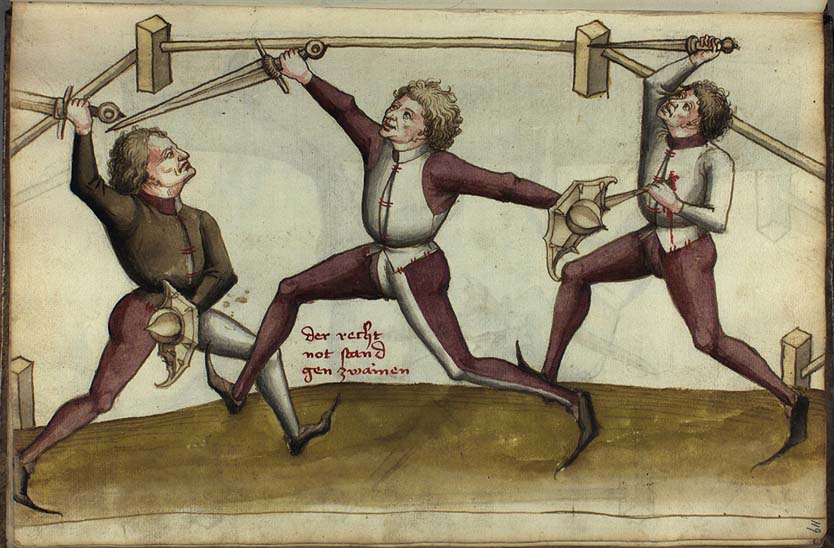
It was an odd experience, coming back to Europe in 2010 after not being involved in the international HEMA scene for 5 years. Whereas the early HEMAC meetings in Dijon were massively polygot (and still are), ranging from reconstructions of Roman combat to 19th century suffragete self-defence, many of the meetings I’ve been to in recent years have been, well, fairly vanilla. Most groups seem to have a single weapon or single source focus, which is very much at odds with the MACS philosophy. When people ask “What type of club are you?”, the general expectation is that you’ll say “Italian longsword”, “German longsword”, “Italian rapier:, etc. When I say “Well, we currently offer German longsword and dussack, with courses in Italian rapier, a study group in Spanish rapier, regular English backsword classes, and as much daggerwork and wrestling as we find time for,” people fall over backwards! That’s before mentioning the stuff we have and can teach, such as Bolognese and Meyer sidesword, I.33 and possibly a bit of smallsword and sabre.
However, we are not dilettantes, and there is method in the madness. Firstly, I believe that different weapons and weapons styles allow you to work on different aspects of fighting. I.33 is great for working on bindwork and closing; rapier teaches you the covering lines and thrusting with opposition; wrestling and daggerwork teaches basic body posture and strength, etc. Secondly, I believe exposure to different styles and approaches, especially more modern styles with better developed pedagogy, allows you to gain more insight into older styles that require more interpretation (rapier and sabre aid our longsword, for instance). Thirdly, more exposure to different systems yields a better balanced fighter.
Expanding on the last point, it should be emphasise that almost of the major traditions we know of are multiple weapons systems. Fiore dei Liberi teaches wrestling, daggerwork, singlesword, longsword, armoured combat with sword and spear, and horseback fighting. The German tradition covers wrestling, daggerwork, messer, longsword, armoured combat,horseback fighting, and in later sources, staff weapons and rapier. Bolognese systems involve numerous weapons types, and even the long rapier systems involve several different weapon pairings (and plenty of promises to show more dagger and wrestling in later volumes). So, multiple different weapons, within and without a system, is common. Furthermore, a number of sources show mixed weapon fighting- Fabris and Meyer defeat polearms with rapiers, Thibault fights the longsword and sword and dagger, and so on.
Now there is an argument that such multiple weapon use is gained by mastering “the system” underlying each master’s work, but alternatively, using different weapons forces one to adapt to different timings and distance, producing a better fighter. I’d argue that fighting against mixed weapons similarly forces a fighter to change timing and distance. Working within a single weapon (as many do) and working within a single system often creates a shared illusion of what constitutes a fight, whereas mixing weapons and styles strips things down to the basics of fighting. Furthermore, your mixed weapons sparring only really works when the person you are facing actually knows what they are doing with the weapon!
That’s not to say that you should swap willy-nilly between weapons and styles, or sacrifice academic integrity (hopefully some of the other articles on this blog show that we don’t lack rigour). We keep certain weapons as core (in my case, German longsword), and then encourage students to add extra styles to this. Everybody needs a core terminology to relate new concepts to, and people naturally gravitate to certain styles more than others. I recommend that every student of mine should aim to conquer a single-hand cutting style, a single-hand thrusting style, a two-handed style, and a two-weapon style, and then exposure to wrestling/dagger and polearms. I myself favour longsword and sidesword.
It’s probably not everybody’s cup of tea- I know some people stick to a single weapon like glue. However, multiple styles and weapons (as far as time and instructor attention allows) has been the MACS way for 15 years, and I don’t see us changing. At the moment, we’re contemplating adding smallsword and Thibault rapier to the knowledge base, and there have been requests to dust off the I.33. At least my life as an instructor is interesting!





